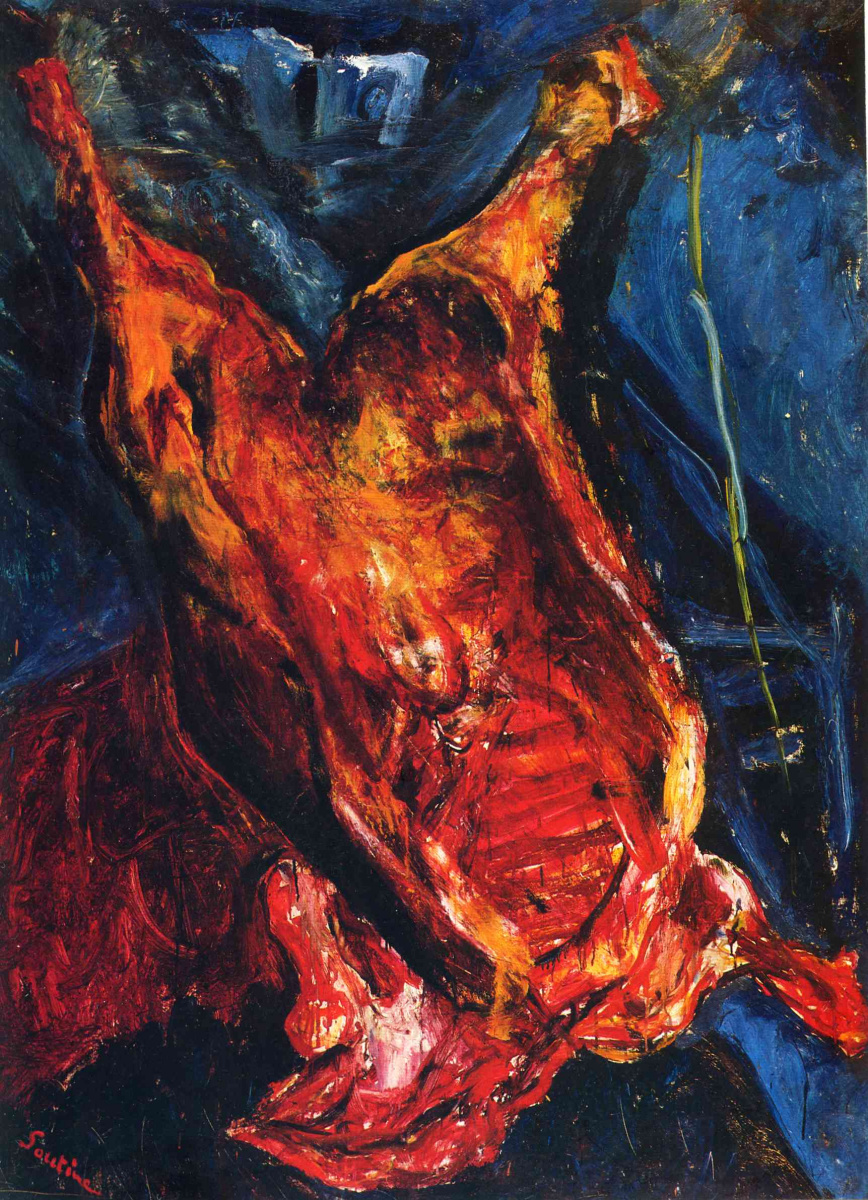log in
Enter site
Login to use Arthive functionality to the maximum
Beef carcass
Chaim Soutine • Painting, 1924, 140.3×107.6 cm
Description of the artwork «Beef carcass»
In 2006, at Christie's London auction "Beef carcass" (one of them) was sold at 13.8 million dollars. The upper estimate was 8.5 million dollars.
In the 1920-ies, after returning from the South of France to Paris, Soutine writes a lot "meat still lifes"including six "Bull carcasses". Five of them are now in different museums and one in a private collection. All the paintings depicted severed and suspended carcass of a bull. This endless dialogue Soutine waged with only his idol, Rembrandt. Seeing in the Louvre "Flayed bull carcass" (1655), Soutine lost the rest. On arriving in France, he left her only once – in order to Amsterdam to see Rembrandt.
"Carcass" of Rembrandt who not only quoted (one of the tireless followers of Francis bacon: 1, 2, 3), but Soutine spent his analogy by its own laws – not as obvious as "is also a dead animal". He found it possible to compare their "carcases" is that scandalous "The origin of the world" Gustave Courbet. Soutine said: "Courbet was able to convey the atmosphere of Paris, drawing female body, I want to show Paris in a bullish touch". With Courbet, it is in common and contradictory attitude that causes both of the depicted nature, aptly defined by researchers as "repelling beauty". In particular, Soutine connection is shocking, not "art" theme (the bloody butchered carcass) and do not let go, blasting the perception of its richness of flavor. Fierce, inside-out carcass of the slaughtered animal seems to be a jewelry box is so dazzling Shine with rubies, sapphires and emeralds, deep red, blue, yellow and green. Art historian Elie Faure believed that from the time of Rembrandt Soutine – the only artist "whose lyricism of matter was extracted from the most secret depths of her".
It is noteworthy that Chaim Soutine always painted solely from life. Thus, for the "meat" of the still lifes he needed to get friendly with abattoirs. The carcass was taken to the house, hung, and the artist enthusiastically wrote, from time to time basting the meat with the blood, when it was chapped. "Bull carcasses" is related a funny story. At that time Marc Chagall he lived on the floor below Soutine. One night Chagall saw that from the ceiling, his blood dripping. Soon she's not just dripping but literally tech. Chagall rushed upstairs in the belief that Soutine kill, and caught him, inspired the writing of the next carcass of a bull, and absolutely not noticing a huge puddle of blood, which this bull a lot.
It is interesting to compare the "mascara" Soutine and Pyotr Konchalovsky. How different gentle, intelligent, lyrical Konchalovsky and furious, suffering, strife-torn Soutine portrayed, in fact, the story.
Author: Alain Esaulova
In the 1920-ies, after returning from the South of France to Paris, Soutine writes a lot "meat still lifes"including six "Bull carcasses". Five of them are now in different museums and one in a private collection. All the paintings depicted severed and suspended carcass of a bull. This endless dialogue Soutine waged with only his idol, Rembrandt. Seeing in the Louvre "Flayed bull carcass" (1655), Soutine lost the rest. On arriving in France, he left her only once – in order to Amsterdam to see Rembrandt.
"Carcass" of Rembrandt who not only quoted (one of the tireless followers of Francis bacon: 1, 2, 3), but Soutine spent his analogy by its own laws – not as obvious as "is also a dead animal". He found it possible to compare their "carcases" is that scandalous "The origin of the world" Gustave Courbet. Soutine said: "Courbet was able to convey the atmosphere of Paris, drawing female body, I want to show Paris in a bullish touch". With Courbet, it is in common and contradictory attitude that causes both of the depicted nature, aptly defined by researchers as "repelling beauty". In particular, Soutine connection is shocking, not "art" theme (the bloody butchered carcass) and do not let go, blasting the perception of its richness of flavor. Fierce, inside-out carcass of the slaughtered animal seems to be a jewelry box is so dazzling Shine with rubies, sapphires and emeralds, deep red, blue, yellow and green. Art historian Elie Faure believed that from the time of Rembrandt Soutine – the only artist "whose lyricism of matter was extracted from the most secret depths of her".
It is noteworthy that Chaim Soutine always painted solely from life. Thus, for the "meat" of the still lifes he needed to get friendly with abattoirs. The carcass was taken to the house, hung, and the artist enthusiastically wrote, from time to time basting the meat with the blood, when it was chapped. "Bull carcasses" is related a funny story. At that time Marc Chagall he lived on the floor below Soutine. One night Chagall saw that from the ceiling, his blood dripping. Soon she's not just dripping but literally tech. Chagall rushed upstairs in the belief that Soutine kill, and caught him, inspired the writing of the next carcass of a bull, and absolutely not noticing a huge puddle of blood, which this bull a lot.
It is interesting to compare the "mascara" Soutine and Pyotr Konchalovsky. How different gentle, intelligent, lyrical Konchalovsky and furious, suffering, strife-torn Soutine portrayed, in fact, the story.
Author: Alain Esaulova


